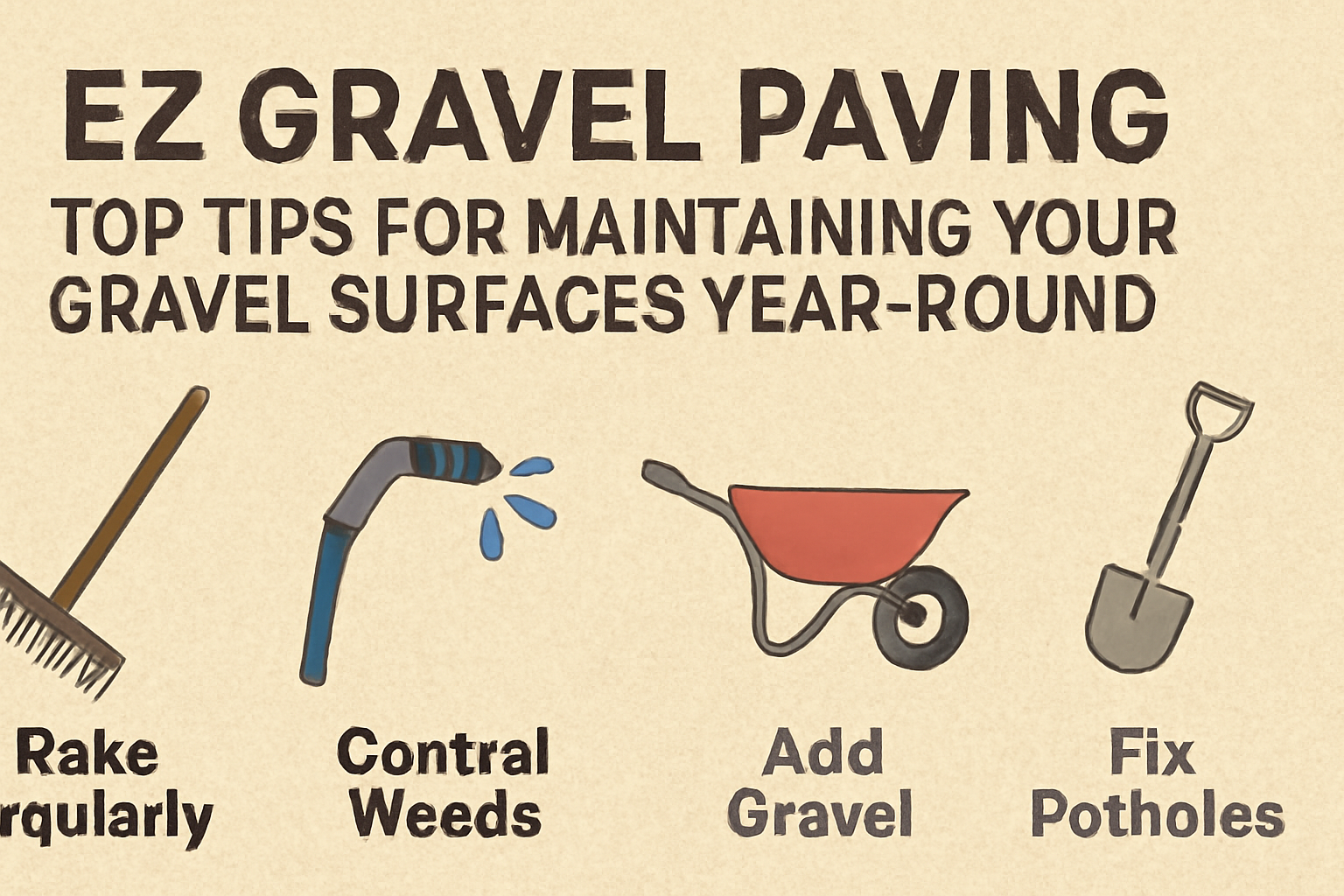EZ Gravel Paving’s Top Tips for Maintaining Your Gravel Surfaces Year-Round

Gravel surfaces, whether for driveways, paths, or patios, offer a versatile and affordable option for homeowners looking to create beautiful, functional outdoor spaces. However, like any outdoor surface, gravel requires some upkeep to stay in top shape throughout the year. Fortunately, maintaining your gravel surfaces doesn’t have to be a daunting task. With a little effort, you can keep your gravel areas looking fresh and well-maintained, no matter the season. EZ Gravel Paving is here to share some top tips for ensuring your gravel surfaces remain in excellent condition year-round.
1. Regularly Replenish Gravel
One of the first steps in keeping your gravel surfaces pristine is to replenish the gravel every year or two. Over time, gravel can shift and settle, creating uneven patches or even bare spots. Adding a fresh layer of gravel helps to restore the evenness and aesthetic appeal of your surface. When choosing new gravel, make sure to select a material that complements the existing gravel to maintain a uniform look.
Not only does replenishing the gravel improve the appearance, but it also contributes to the longevity of your gravel surface. Fresh gravel helps improve drainage, preventing water from pooling and potentially eroding the surface. This is especially crucial during rainy seasons when water runoff can cause serious damage to improperly maintained gravel areas.
2. Keep It Level with Regular Raking
A key aspect of gravel maintenance is ensuring that your surface stays level. Over time, gravel can become uneven due to weather conditions, heavy traffic, or general wear and tear. Regularly raking the gravel helps to redistribute it and fill in any low spots. This simple task ensures that your driveway, patio, or path remains smooth and easy to navigate, preventing the formation of divots or puddles.
Use a landscape rake with curved teeth for the best results. These rakes are designed to pull the gravel in an even manner, helping you achieve a consistent surface without causing too much disruption. This task can be done as often as necessary, depending on the amount of traffic your gravel surface experiences.
3. Invest in Low-Maintenance Gravel Driveways
One of the easiest ways to reduce the effort required for gravel maintenance is to invest in low-maintenance gravel driveways. These types of driveways are designed to stay level and intact for longer periods, which means less frequent raking and replenishing. Low-maintenance gravel driveways use a special mixture of gravel and materials that reduce shifting and erosion, making them an excellent choice for homeowners looking to minimize upkeep.
In addition, low-maintenance gravel driveways are more durable and can handle harsh weather conditions without needing constant attention. With the right installation and care, you can enjoy the beauty and practicality of a gravel surface without the usual maintenance challenges. If you’re looking for a more hands-off approach to gravel maintenance, this could be the solution you need.
4. Address Weeds and Vegetation Growth
Weeds are a common issue for gravel surfaces, as the small cracks between the stones provide an ideal environment for seeds to take root. If left unchecked, weeds can quickly take over your gravel driveway, path, or patio, leading to an unsightly and uneven surface. To prevent weed growth, you should regularly inspect your gravel area and remove any weeds as soon as they appear.
There are a few ways to keep weeds at bay. Hand-pulling weeds is the simplest method, but for more stubborn plants, you may want to use a weed barrier fabric or apply a non-toxic herbicide. The key is to address the problem early before it becomes a bigger issue. Preventative measures like sealing the surface or adding a layer of gravel with smaller particles can also help reduce the chances of weeds taking hold.
5. Ensure Proper Drainage
Proper drainage is essential for maintaining the integrity of your gravel surface. If water is allowed to pool on your driveway, path, or patio, it can lead to erosion, uneven surfaces, and a decrease in the lifespan of your gravel. Ensuring that your gravel surface is properly sloped and has adequate drainage is key to preventing water damage.
If you notice that water tends to pool in certain areas, consider adding more gravel or adjusting the grading to create a slight slope that directs water away from the surface. Installing drainage systems such as French drains or surface drains can also help manage water flow, preventing it from causing long-term damage to your gravel surfaces.
6. Compact the Gravel
When gravel is first laid down, it’s important to compact it to create a solid, stable surface. Over time, however, gravel can loosen, leading to an uneven and unstable surface. Compacting the gravel every year or two helps to prevent this and ensures that your surface remains firm and reliable.
To compact gravel, use a mechanical compactor or plate compactor, which can be rented from most home improvement stores. This equipment will help to lock the gravel in place, reducing the risk of shifting and settling. A well-compacted gravel surface is not only safer to drive or walk on but also requires less maintenance overall.
7. Address Potholes and Depressions
Potholes and depressions are common issues with gravel surfaces, especially if the area experiences heavy traffic or frequent weather changes. These holes can cause damage to vehicles and make walking on the surface uncomfortable. Luckily, potholes and depressions are relatively easy to fix with a few simple steps.
To repair a pothole or depression, start by removing any loose gravel and debris from the area. Then, fill the hole with fresh gravel, making sure to compact it as you go. It’s important to ensure that the repaired area is level with the surrounding surface to prevent further damage. Regularly checking for potholes and fixing them promptly will help extend the life of your gravel surface and keep it looking great.
8. Clean Your Gravel Surface
Cleaning your gravel surface regularly is an important part of maintaining its appearance. Over time, dirt, debris, and organic material can accumulate on the surface, making it look dirty and unattractive. A quick cleaning routine can help to restore the fresh look of your gravel and keep it free from debris that could damage the surface.
To clean your gravel, simply use a broom to sweep away any loose debris. For more stubborn dirt or stains, you may need to use a power washer or hose to rinse the surface. Just be sure not to use too much water pressure, as this can shift the gravel and cause erosion. Regular cleaning helps prevent dirt buildup, making it easier to maintain the integrity and aesthetic of your gravel surface.
9. Protect the Surface from Heavy Traffic
Heavy traffic can be one of the biggest contributors to gravel surface damage. Whether it’s from vehicles, lawnmowers, or foot traffic, constant pressure can cause the gravel to shift, settle, and become uneven. To protect your gravel surface, try to limit heavy traffic to certain areas and maintain designated paths.
For driveways, consider installing a gravel grid system that helps to keep the gravel in place, preventing shifting and rutting. If you have a gravel path or patio, adding stepping stones or pavers in high-traffic areas can also help protect the surface. By reducing the amount of heavy pressure on your gravel, you can extend its lifespan and minimize the need for repairs.
10. Seal the Gravel for Extra Protection
While sealing gravel is not always necessary, it can offer additional protection, especially in areas that experience harsh weather conditions. A good gravel sealant can help to bind the stones together, reducing shifting and erosion. It can also protect the gravel from UV damage and prevent water from seeping into the surface.
If you choose to seal your gravel surface, be sure to select a sealant that is designed for outdoor use and is compatible with your specific type of gravel. Apply the sealant according to the manufacturer’s instructions, and avoid using it too frequently, as over-sealing can lead to an unnatural appearance and cause the gravel to become compacted and difficult to repair.
Conclusion
Maintaining your gravel surfaces year-round doesn’t have to be difficult or time-consuming. By following these simple tips, you can ensure that your gravel driveway, path, or patio remains in excellent condition for years to come. Regular replenishing, leveling, and cleaning, along with addressing issues like weeds and drainage, will help to keep your gravel surfaces looking beautiful and functional. With a little attention and care, your gravel areas will continue to provide value and charm to your property.
For expert guidance on maintaining your gravel surfaces, visit https://ezgravelpaving.com/.
